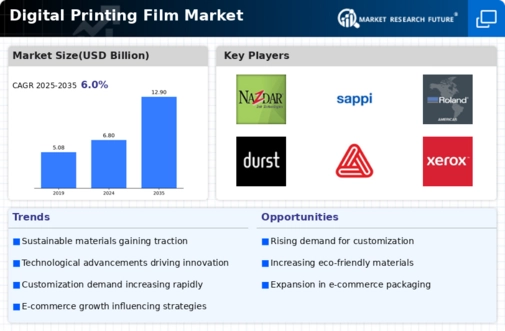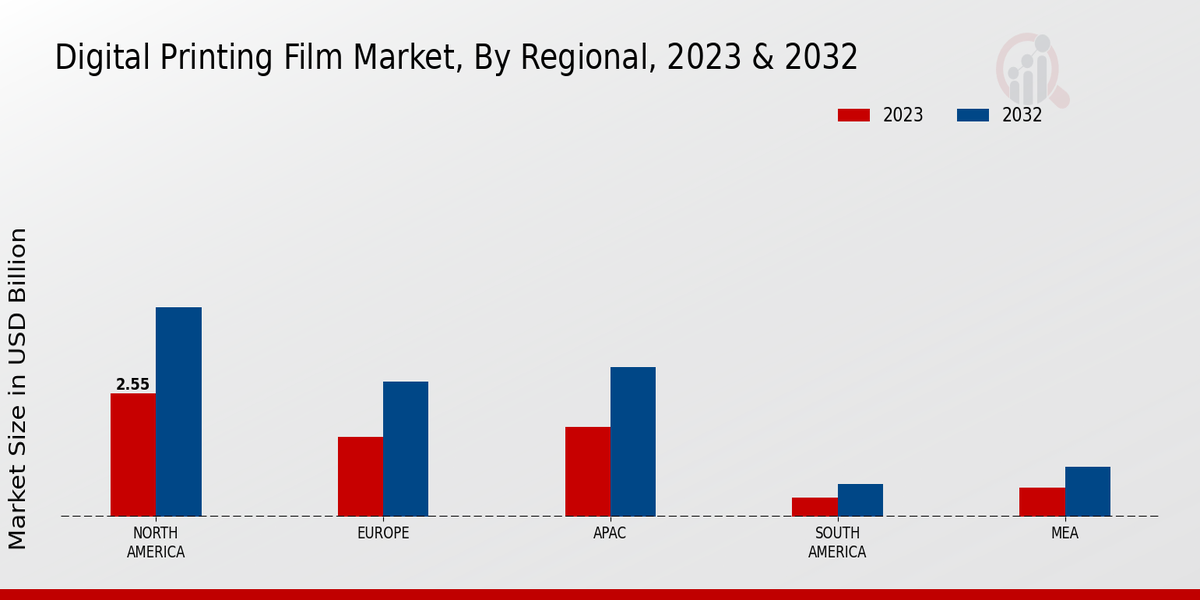Market Growth Projections
The Global Digital Printing Film Market Industry is poised for substantial growth, with projections indicating a market value of 6.8 USD Billion in 2024 and an anticipated increase to 12.9 USD Billion by 2035. This growth trajectory suggests a robust compound annual growth rate (CAGR) of 5.97% from 2025 to 2035. Such projections reflect the industry's adaptability to changing consumer preferences and technological advancements. The increasing demand for customized and sustainable printing solutions further supports this growth, indicating a dynamic market landscape that is likely to evolve in response to emerging trends and innovations.
Growing Demand for Customization
The Global Digital Printing Film Market Industry experiences a surge in demand for customized products across various sectors, including packaging, textiles, and signage. This trend is driven by consumers' increasing preference for personalized items, which necessitates flexible printing solutions. As businesses strive to differentiate themselves in a competitive landscape, digital printing films provide the necessary versatility to produce unique designs efficiently. The market is projected to reach 6.8 USD Billion in 2024, reflecting the industry's adaptation to consumer preferences for tailored solutions. This growing demand for customization is likely to propel the market further, fostering innovation in digital printing technologies.
Diverse Applications Across Industries
The Global Digital Printing Film Market Industry benefits from its diverse applications across various sectors, including automotive, healthcare, and advertising. Each industry demands specific printing solutions that cater to unique requirements, such as durability, flexibility, and aesthetic appeal. For instance, automotive manufacturers utilize digital printing films for vehicle wraps and interior designs, while healthcare providers employ them for labeling and signage. This versatility allows the market to tap into multiple revenue streams, fostering resilience against economic fluctuations. As industries continue to evolve, the demand for specialized digital printing films is expected to grow, further solidifying the market's position.
Expansion of E-Commerce and Online Retail
The expansion of e-commerce and online retail significantly influences the Global Digital Printing Film Market Industry. As online shopping continues to grow, businesses require effective packaging solutions that enhance brand visibility and consumer engagement. Digital printing films offer the flexibility to create eye-catching packaging designs that cater to diverse consumer preferences. This trend is particularly evident in the food and beverage sector, where packaging plays a crucial role in attracting customers. The increasing reliance on digital printing for packaging solutions is likely to drive market growth, as companies seek to optimize their branding strategies in the competitive e-commerce landscape.
Technological Advancements in Printing Techniques
Technological advancements play a pivotal role in shaping the Global Digital Printing Film Market Industry. Innovations in printing technologies, such as inkjet and laser printing, enhance the quality and efficiency of printed materials. These advancements enable faster production times and improved color accuracy, which are crucial for meeting the evolving demands of various industries. As a result, manufacturers are increasingly adopting digital printing films to leverage these technologies. The market's growth trajectory, with a projected CAGR of 5.97% from 2025 to 2035, underscores the importance of continuous technological evolution in driving market expansion.
Sustainability Initiatives and Eco-Friendly Materials
Sustainability initiatives are becoming increasingly relevant within the Global Digital Printing Film Market Industry. As environmental concerns rise, businesses are seeking eco-friendly printing solutions that minimize waste and reduce carbon footprints. Digital printing films made from recyclable and biodegradable materials are gaining traction, aligning with global sustainability goals. This shift not only meets regulatory requirements but also appeals to environmentally conscious consumers. The industry's commitment to sustainability is expected to contribute to its growth, as more companies adopt green practices. This trend may further enhance the market's value, potentially reaching 12.9 USD Billion by 2035.










